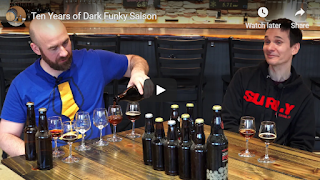Much-loved hop harvest celebration returns in March after being cancelled in 2020.
The post Beechworth’s High Country Hop returns appeared first on Beer & Brewer.
Much-loved hop harvest celebration returns in March after being cancelled in 2020.
The post Beechworth’s High Country Hop returns appeared first on Beer & Brewer.
Build Me A Brewery delves into the dos and don’ts so you don’t have to.
The post The ‘reality check’ podcast for start-ups appeared first on Beer & Brewer.
Brewery release hoppiest canned beer to date in tribute to installing solar panels.
The post Colonial Brewing make beer from sunshine appeared first on Beer & Brewer.
Canberra brewery create a new sour to celebrate forthcoming art exhibition.
The post Capital Pucker Up with new love potion appeared first on Beer & Brewer.
When The Virginia Beer Company’s management team made the executive decision on 3/16/2020 to close their taproom and shift entirely to curbside to-go operations, there was no precedent for how to plan for the future of the business. But one focus remained clear: do everything possible to keep every member of the Virginia Beer Co. […]
The post Virginia Beer Co. Completes Brewery Expansion Projects Ahead of 5-Year Anniversary appeared first on CraftBeer.com.
Celebrate Winter Bonfire Bash Series, Lumberjack Competition, Frying Pan Toss, Return of Husky Hamburger, Flapjacks & Flannel and Much More Highlight 2021 Winter Events Central Virginia’s Stable Craft Brewing at Hermitage Hill, an authentic working farm brewery and winery, is pleased to announce its 2021 January through March special event schedule. Saturday’s will come alive […]
The post Stable Craft Brewing At Hermitage Hill Announces 2021 January – March, 2021 Special Events appeared first on CraftBeer.com.
 Michael Tonsmeire from Sapwood Cellars joins me this week to discuss some of the less glamorous aspects of running a small craft brewery. Subscribe on iTunes to Audio version or Video version or Spotify or Google Play Download the MP3 File– Right Click and Save As to download this mp3 file. Your browser does not […]
Michael Tonsmeire from Sapwood Cellars joins me this week to discuss some of the less glamorous aspects of running a small craft brewery. Subscribe on iTunes to Audio version or Video version or Spotify or Google Play Download the MP3 File– Right Click and Save As to download this mp3 file. Your browser does not […] “Champion Brewery” has a nice ring to it, and that’s just what Beer52 — a United Kingdom based craft beer cultivation and subscription organization that serves thousands of international brews annually throughout the UK — has named The Virginia Beer Company. There is no secret that Williamsburg’s Virginia Beer Co. loves sharing beers & cheers […]
The post Virginia Beer Co. Receives Top International Recognition appeared first on CraftBeer.com.
 Jeff Bloem joins me from Murphy & Rude Malting to discuss Craft Malting and brewing with Craft Malts. Subscribe on iTunes to Audio version or Video version or Spotify or Google Play Download the MP3 File– Right Click and Save As to download this mp3 file. Your browser does not support the audio element. Topics […]
Jeff Bloem joins me from Murphy & Rude Malting to discuss Craft Malting and brewing with Craft Malts. Subscribe on iTunes to Audio version or Video version or Spotify or Google Play Download the MP3 File– Right Click and Save As to download this mp3 file. Your browser does not support the audio element. Topics […] When the Brewers Association released the results of their Brewery Operations Benchmarking Survey last year, the data confirmed that there’s still work to do when it comes to diversifying the industry. Based on the responses, 77 percent of breweries were owned by men and only 9 percent of breweries owned by people of color. More […]
The post Creating Safe Spaces for Women in the Beer Industry appeared first on CraftBeer.com.
These classic Christmas beers from craft breweries pair perfectly whether you’re looking to share a bottle with friends or enjoy as you’re decorating the house for the holidays.
The post 12 Beers of Christmas appeared first on CraftBeer.com.
Solve all of yours (and your dog’s) holiday shopping needs with Stable Craft’s Holiday Gift Cards Central Virginia’s Stable Craft Brewing at Hermitage Hill, an authentic working farm brewery and winery, is making holiday shopping safer and more seamless this season, with the offering of its Stable Craft Holiday Gift cards. In addition to being the perfect […]
The post Stable Craft Brewing’s 2020 Holiday Gift Guide For You And Your Four-Legged BFF appeared first on CraftBeer.com.
The Brewers Association is leading a charge on promoting all the small breweries that bring you craft beer to your communities. Celebrate the craft by joining us throughout the weekend but especially on November 29, 2020 as we release some archives for your taste bud enjoyment.
The post Woods Boss Brewing Small Brewery Sunday appeared first on CraftBeer.com.
The Virginia Beer Company (Williamsburg, VA) will mark the holiday season with the return of their seasonal Spiced Milk Stout, Evil Santa. “Since the first winter we were open back in 2016, Evil Santa has been one of our most sought after recipes,” reminisces Co-Founder Robby Willey. “The branding is playful, the time of year […]
The post Virginia Beer Co. Releases Four Evil Santa Spiced Milk Stout Variants appeared first on CraftBeer.com.
Fresh Fruit From the Farm Ciders Plus a Special Oyster Fest & Fish Fry & Oyster Stout Release Highlight Weeklong Cider Celebration! Central Virginia’s Stable Craft Brewing at Hermitage Hill, an authentic working farm brewery and winery, will kick off Virginia Craft Cider week with a week-long cider celebration featuring an array of fresh from the […]
The post Stable Craft Brewing At Hermitage Hill Kicks Off Virginia Craft Cider Week With An Array Of Refreshing Ciders Starting November 13-22nd appeared first on CraftBeer.com.
The #1 winter seasonal beer1 returns with a crisper and brighter recipe and festive inspiration for holidays spent at home BOSTON, MA, Nov. 9, 2020—Samuel Adams brewers recognize the winter season will feel different this year, with many Americans taking “home for the holidays” literally. To spread some holiday cheer when drinkers need it most, […]
The post Samuel Adams’ New Winter Lager Brings A Wintery Remix To Holiday Classics appeared first on CraftBeer.com.
German Master Brewer Peter Bottcher and Catoctin Creek Distillery’s John Reed Shope Join Line-up for Entertaining Two Day Release Party! Central Virginia’s Stable Craft Brewing at Hermitage Hill, an authentic working farm brewery and winery, will celebrate the release of its popular Cavallo barrel-aged imperial stout on Friday and Saturday, November 6 & 7, 2020. This […]
The post Special Cavallo Release Party Features Four Variants, Dessert Pairings And Two Special Guests On Friday & Saturday, November 6 & 7, 2020 At Stable Craft Brewing At Hermitage Hill appeared first on CraftBeer.com.
Festive Day Features Special Veterans Day IPA Release with Yakima Chiefs Veterans Blend, Special Commemorative Glass, and Marine’s Cake-cutting Ceremony WAYNESBORO, VA – (November 2, 2020) – Central Virginia’s Stable Craft Brewing at Hermitage Hill, an authentic working farm brewery and winery, will honor the special men and women who serve our country, with a special Veteran’s […]
The post Stable Craft Brewing At Hermitage Hill Salutes Our Veterans With Special Veteran’s Day Celebration On Sunday, November 8 appeared first on CraftBeer.com.
In August 2020, the federal Food & Drug Administration (FDA) finalized the definition and labeling requirements of gluten-free fermented and hydrolyzed foods (including beer and other alcoholic beverages). The ruling provides a clear delineation between products that are truly gluten-free and products that are not and how product labels communicate those differences to consumers. In […]
The post Gluten-Free Brewers Group Responds to FDA Final Rule on Gluten-Free Claims on Fermented Foods appeared first on CraftBeer.com.
Private Igloos Offer Perfect Answer for Outdoor Winter Dining WAYNESBORO, VA – (October 21, 2020) –Starting this November, Central Virginia’s Stable Craft Brewery at Hermitage Hill, an authentic working farm brewery and winery, will once again offer its private igloos for outdoor dining at its best. Stable Craft’s heated igloos are available by advance reservations only […]
The post Reserve Your Own Private Igloo At Stable Craft Brewing appeared first on CraftBeer.com.
WAYNESBORO, VA – (October 20, 2020) – Central Virginia’s Stable Craft Brewery at Hermitage Hill, an authentic working farm brewery and winery, was the site of a World Record record-shattering performance by Stephen Clarke, the World’s Fastest Pumpkin Carver on Saturday, October 17. Clarke broke his Guinness World Record of 16.47 seconds for speed carving a […]
The post World’s Fastest Pumpkin Carver Shatters Guinness World Record For Speed Carving A Single Pumpkin At Stable Craft Brewing’s Fall Harvest Party appeared first on CraftBeer.com.
272 medals awarded to 240 breweries in world’s most prestigious professional beer competition Boulder, Colo. • October 16, 2020 — The Brewers Association (BA) awarded 272 medals* to 240 breweries across the country during the 2020 Great American Beer Festival (GABF) competition awards ceremony. The best beers in 91 beer categories covering 170 different beer styles (including all subcategories) were awarded gold, silver, and bronze medals during a virtual ceremony hosted on The Brewing Network. Judges for the 34th edition of […]
The post Winners of 2020 Great American Beer Festival Competition Revealed During First-Ever Virtual Ceremony appeared first on CraftBeer.com.
Fretboard Brewing Company (Blue Ash, OH) isn’t known for their collaborations with other breweries. Over the course of their 3 year history, they’ve partnered with musicians like Bootsy Collins and The Cliftones, to foundations like ArtsWave, and even a bread company (Klosterman Baking), but they’ve never released a product brewed in partnership with another brewery. […]
The post Fretboard Brewing and Branch & Bone Artisan Ales team up for “Dark Throne” Collaboration appeared first on CraftBeer.com.
For us homebrewers that enter a competition sanctioned by the Beer Judge Certification Program (BJCP), the goal is clear – we want feedback on our brews from trained tasters. And, if we win an award, we want to strut. As homebrewers progress to professional brewing, little changes in regard to competition goals. Professional brewers still […]
The post The Untold Benefits of Award-Winning Beer appeared first on CraftBeer.com.
World’s Fastest Pumpkin Carver Attempts New Guinness World Record, Pumpkin Drop, Grab the Oktoberfest Glass, Socially Distanced Stein Hoist and Many More Fun Fall Festivities WAYNESBORO, VA – (October 5, 2020) – Central Virginia’s Stable Craft Brewery at Hermitage Hill, an authentic working farm brewery and winery, offers the perfect venue and party to celebrate […]
The post Experience Virginia’s Fall Foliage At Stable Craft Brewing’s Fall Harvest Party On Saturday October 17 appeared first on CraftBeer.com.
OREGON CITY, Ore.––Sept. 29, 2020––While 2020 has led to closures and downsizing for many small businesses, Coin Toss Brewing is thrilled to announce an expansion. The Oregon City brewery and taproom, located at 14214 Fir St., Unit H, is taking over an adjacent suite in its building complex. The new space is approximately 1,500 square […]
The post Coin Toss Brewing Defies the Pandemic Odds, Announces Expansion of its Oregon City Brewery and Taproom appeared first on CraftBeer.com.
 Ted Fleming joins me this week from Partake Brewing to discuss how to brew alcohol free beer at home. Subscribe on iTunes to Audio version or Video version or on Google Play Download the MP3 File– Right Click and Save As to download this mp3 file. Your browser does not support the audio element. Topics […]
Ted Fleming joins me this week from Partake Brewing to discuss how to brew alcohol free beer at home. Subscribe on iTunes to Audio version or Video version or on Google Play Download the MP3 File– Right Click and Save As to download this mp3 file. Your browser does not support the audio element. Topics […] 

